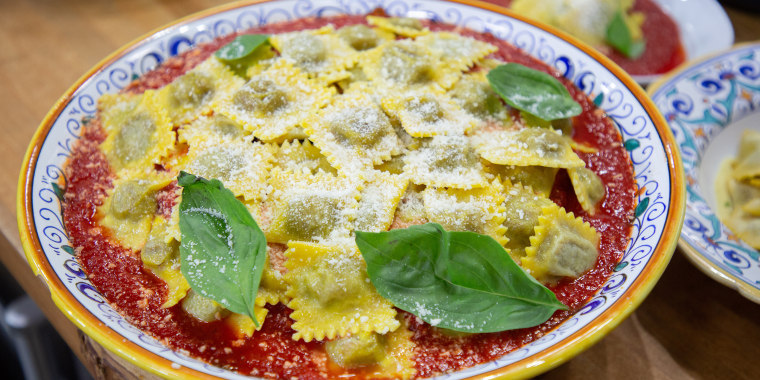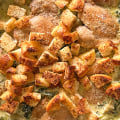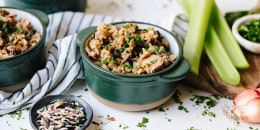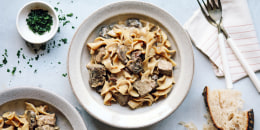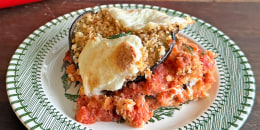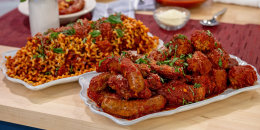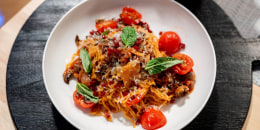Chef notes
Ravioli is a pasta that makes people happy. I started making this dish over 20 years ago and now it's a permanent fixture on my menu. The recipe is not exactly like my grandmother's ravioli — I've done a little cheffy tweaking — but it's pretty close to her own Sunday-supper specialty.
Technique tip: It's a good idea to make the pasta dough and the filling a day or two before you need it — the filling takes some time to cook and cool, but it will hold for two days in the fridge. When making the dough, keep the dough as thin as possible - it eats better. When making the dough, let it sit at room temperature wrapped up tightly for 1-2 hours to temper and to hydrate. It will give more elasticity to the dough.
Ingredients
- 1/2 pound veal stew meat, cut into 1½-inch cubes
- 1/2 pound beef short ribs, cut into 1½-inch cubes
- 1/2 pound pork butt, cut into 1½-inch cubes
- 1 teaspoon salt
- 1/2 teaspoon freshly ground black pepper
- 2 tablespoons extra virgin olive oil
- 1/2 cup (about 3 ounces) roughly chopped bacon
- 1 small onion, roughly chopped
- 1 small carrot, sliced
- 1 stalk celery, roughly chopped
- 1 beefsteak tomato, cored and roughly chopped
- 1 clove garlic, smashed
- 1 tablespoon tomato paste
- 1 tablespoon all-purpose flour
- 1 cup dry red wine
- 2 bay leaves
- 2 cups chicken broth
- 2 egg yolks
- 1/3 cup grated Parmigiano-Reggiano
- 1 pinch nutmeg
- 6 cups "00" flour, plus more
- 1 teaspoon salt
- 7 eggs
- 5 egg yolks
- 2 tablespoons olive oil
- 1 egg
- 1 tablespoon water
- 10 cups good quality Italian canned tomatoes, such as San Marzano
- 1 heaping teaspoon sea salt or kosher salt
- 1 head garlic
- 1¼ cups extra virgin olive oil
- 1 packed cup basil leaves, washed with stems on
- 1 teaspoon crushed red pepper flakes
- 2 tablespoons extra virgin olive oil
- 2 tablespoons butter
- 1/2 cup grated Parmigiano-Reggiano
- 1/2 cup fresh basil, chopped
Preparation
For the filling:
1.Place the veal, beef, and pork on a large plate and season the meat all over with the salt and pepper.
2.Heat the olive oil over high heat in a large pot. Add the meat and cook until it's browned, about 2-3 minutes.
3.Add the bacon, onion, carrot, and celery and cook together until the vegetables soften and begin to brown, about 5 minutes, stirring occasionally.
4.Add the tomato, smashed garlic clove and tomato paste. Stir everything together so that all the ingredients are glazed with the tomato paste, about 1 minute.
5.Add the flour and mix it in well, so that the meat and the vegetables are coated. Cook the starchy flavor of the flour out a bit, about 2 minutes.
6.Add the wine and bay leaves and mix well. Allow the liquid to reduce by 3/4, about 2 minutes.
7.Add the chicken broth. With a rubber spatula (or a wooden spoon), carefully scrape down the sides of the pot above the mixture so that any bits that have landed on the sides don't burn and flavor the filling. Lower the heat to medium-low, cover the pot, and simmer until the meat has broken down into little bits, most of the liquid has reduced, and the mixture looks like a thick, delicious, fragrant stew, about 2½ hours. Check the mixture periodically as it cooks to make sure it doesn't come up to a boil (it's important to make sure that the mixture is not really wet but just moist when it's done: there should be just a little liquid in the bottom to glaze up the meat).
8.Remove the pot from the heat and allow the mixture to cool. When the mixture has cooled, you have three options: use your hands to squeeze the meat bits up and break everything (including the vegetables) apart, use a food processor and pulse until the mixture is coarsely ground or put the filling through a meat grinder using a large die. When you're done, the filling should look as if it's been roughly chopped.
For the pasta dough:
1.Flour a work surface well.
2.Combine the flour and the salt in the bowl of a stand mixer fitted with a dough hook and combine on low speed.
3.Add the eggs, egg yolks and olive oil. Turn it up to medium speed and mix until it looks like a rough dough, about 30 seconds.
4.Remove the dough from the machine and mix it well with your hands, first in the bowl (to scoop up and integrate the unmixed flour on the bottom) and then on the floured board or work surface to ensure that everything is very well combined.
5.Return the dough to the stand mixer and blend on medium-low speed just until the mixture comes away from the sides of the bowl, 15 seconds or so.
6.Flour your work surface again and turn the dough out onto it. Sprinkle flour on the dough to keep it from sticking.
7.Roll the dough into a ball. Reach over the top of the ball, hook your fingers in, and fold it back towards you; then press the folded bit in with the heel of your hand. (You're basically turning the outside part into the inside part.) That, repeated many times, is how the dough is worked. Keep adding lots of flour, so the dough is not sticky. When the dough is nice and smooth on the outside, like a well-kneaded bread dough, (you want this pasta dough to be really light colored and smooth) — this takes about 3 minutes — form it into a tight ball.
8.Wrap it snugly in 2 layers of plastic wrap, so it's nice and tight, and put it in the fridge to rest for at least 2 hours, preferably overnight.
For the ravioli:
1.Remove the ravioli dough from the fridge and turn it out onto a well-floured surface. With a wooden rolling pin, roll the dough out into a square or rectangle, so that it fits inside your pasta machine.
2.Flour the pasta dough to prevent stickiness and roll it through the pasta machine. Cut the resulting sheet of dough in half (so the final sheet doesn't get too long). Roll the pasta dough through the machine again, reducing the setting. Repeat until the dough is thin enough to allow you to see the outline and color of your hand through it, but not so thin that it gets fragile (it should feel like a piece of velvet). At this point, run the dough through the machine once more without changing the setting.
3.Make an egg wash by beating the egg together with 1 tablespoon of water.
4.Cut the pasta lengthwise into 3-inch-wide strips and brush the egg wash all over so that it's evenly covered.
5.Remove the ravioli filling from the fridge. Place 1-tablespoon-sized balls of filling at 1-inch intervals along the middle of the strip of pasta. Fold the dough lengthwise over the tops of the filling balls and pinch it shut at the open edge with your fingers. The dough should be grainy with flour on the outside when you fold it over; if it's not, sprinkle on a little more flour so the top isn't sticky.
6.Using two fingers (one on each side of the filling ball), press the pasta dough down around the filling balls, so that they're sealed in (they look a bit like sand dunes poking up from a desert when you're done).
7.Cut the ravioli using a fluted pastry cutter or a pizza cutter (if you don't have one, you can use a knife, but it won't give you that good-looking ravioli edge). The trick is to press your fingers down next to the ravioli ball and cut on the outside of them, pressing the cutter hard so the edge is clean.
8.If you're not serving the ravioli right away, you can freeze them at this point (they'll keep for up to 2 weeks in an airtight container). But if you're moving on, put them on a plate and proceed directly to cooking.
For the sauce:
1.Add the canned tomatoes into a large pot with wide surface area and break them apart into large chunks with your hands. Add the salt. Turn the stove to medium heat and let the tomatoes cook down at a lazy bubble for about 30 minutes. Stir occasionally to prevent sticking. Remove excess liquid with a ladle. Smash the tomatoes as they cook with a wooden spoon so the sauce gradually becomes smoother.
2.Cut the top of the garlic head so that the skin stays on but the tops of the cloves are exposed. Combine the garlic, oil, basil leaves and red pepper flakes in a separate small pot over medium heat and bring to a simmer. As soon as the basil leaves crack take the mixture off the heat and reserve.
3.When the tomato sauce is reduced by 1/2 to 2/3 and is thick but still bright red, strain the oil into the pot and stir to combine.
4.Cook the sauce for about 10 more minutes at a lazy bubble. Stir occasionally to keep from sticking. When the oil and tomatoes have completely emulsified and the sauce looks whole turn off the heat and stir it up a bit with a masher or a hand-blender set on low.
5.Mix the sauce with the pasta or gnocchi while it's hot, or allow the sauce to cool before storing in the freezer or fridge.
To serve:
1.Bring a large pot of salted water to a boil.
2.Drop in the ravioli and cook until they bob to the surface and float, about 2 minutes.
3.Meanwhile, warm the tomato sauce in a large pan on the stove over medium heat until it reaches a very slow bubble.
4.Drain the ravioli but do not rinse them; you want all that stickiness so the sauce will adhere.
5.Remove the sauce from the heat and add the ravioli. Toss everything together well, so that all the ravioli are well coated with the sauce. Add the olive oil, butter, Parmigiano-Reggiano and basil and mix well. Serve immediately, sprinkled with more Parmigiano-Reggiano.
